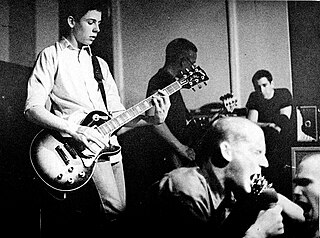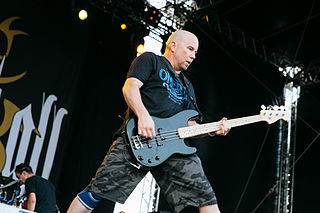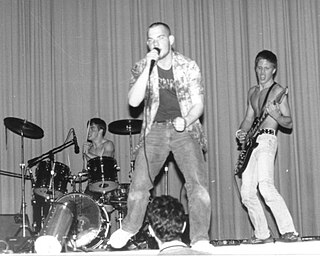Grindcore is an extreme fusion genre of heavy metal and hardcore punk that originated in the mid-1980s, drawing inspiration from abrasive-sounding musical styles, such as: thrashcore, crust punk, hardcore punk, extreme metal, and industrial. Grindcore is considered a more noise-filled style of hardcore punk while using hardcore's trademark characteristics such as heavily distorted, down-tuned guitars, grinding overdriven bass, high speed tempo, blast beats, and vocals which consist of growls and high-pitched shrieks. Early groups like Napalm Death are credited with laying the groundwork for the style. It is most prevalent today in North America and Europe, with popular contributors such as Brutal Truth and Nasum. Lyrical themes range from a primary focus on social and political concerns, to gory subject matter and black humor.

Hardcore punk is a punk rock music genre and subculture that originated in the late 1970s. It is generally faster, harder, and more aggressive than other forms of punk rock. Its roots can be traced to earlier punk scenes in San Francisco and Southern California which arose as a reaction against the still predominant hippie cultural climate of the time. It was also inspired by New York punk rock and early proto-punk. New York punk had a harder-edged sound than its San Francisco counterpart, featuring anti-art expressions of masculine anger, energy, and subversive humor. Hardcore punk generally disavows commercialism, the established music industry and "anything similar to the characteristics of mainstream rock" and often addresses social and political topics with "confrontational, politically-charged lyrics."
Thrash metal is an extreme subgenre of heavy metal music characterized by its overall aggression and often fast tempo. The songs usually use fast percussive beats and low-register guitar riffs, overlaid with shredding-style lead guitar work. The lyrical subject matter often deals with criticisms of The Establishment and concern over the destruction of the environment, and at times shares a disdain for Christian dogma resembling that of their black metal counterparts. The language is typically quite direct and denunciatory, an approach borrowed from hardcore punk.
A number of heavy metal genres have developed since the emergence of heavy metal during the late 1960s and early 1970s. At times heavy metal genres may overlap or are difficult to distinguish, but they can be identified by a number of traits. They may differ in terms of: instrumentation, tempo, song structure, vocal style, lyrics, guitar playing style, drumming style, and so on.
Crust punk is a form of music influenced by English punk rock and extreme metal. The style, which evolved in the early-1980s in England, often has songs with dark and pessimistic lyrics that linger on political and social ills. The term "crust" was coined by Hellbastard on their 1986 Ripper Crust demo.
Extreme metal is a loosely defined umbrella term for a number of related heavy metal music subgenres that have developed since the early 1980s. It has been defined as a "cluster of metal subgenres characterized by sonic, verbal, and visual transgression".
Metalcore is a fusion music genre that combines elements of extreme metal and hardcore punk. As with other styles blending metal and hardcore, such as crust punk and grindcore, metalcore is noted for its use of breakdowns, slow, intense passages conducive to moshing. Other defining instrumentation includes heavy guitar riffs, occasional blast beats, and double bass drumming. Vocalists in the genre typically yell or scream. Some later metalcore bands combine this with clean singing, often during the chorus. Death growls and gang vocals are common. 1990s metalcore bands were inspired by hardcore while later metalcore bands were inspired by melodic death metal. Melodic death metal bands like At the Gates and In Flames influenced later metalcore bands.

Thrashcore is a fast tempo subgenre of hardcore punk that emerged in the early 1980s. Thrashcore is essentially sped-up hardcore, often using blast beats. Songs can be very brief, and thrashcore is in many ways a less dissonant, less metallic forerunner of grindcore. The genre is sometimes associated with skateboarder subculture.

Discharge are an English hardcore punk band formed in 1977 in Stoke-on-Trent by Terence "Tezz" Roberts and Royston "Rainy" Wainwright. While the band has undergone several line-up changes throughout its history, the classic line-up from the early 1980s featured bassist Wainwright, drummer Gary Maloney, Anthony "Bones" Roberts playing guitar, and vocalist Kelvin "Cal" Morris.

New York hardcore is both the hardcore punk music created in New York City and the subculture and lifestyle associated with that music. New York hardcore grew out of the hardcore scene established in Washington, D.C., by bands such as Bad Brains and Minor Threat. Initially a local phenomenon of the 1980s and 1990s, New York hardcore eventually grew to establish an international reputation with little to moderate mainstream popularity but with a dedicated and enthusiastic underground following, primarily in Europe and the United States. With a history spanning over more than 3 decades, many of the early New York hardcore bands are still in activity to this day, some of them being continuously or almost continuously active since their formation and also in the form of reunion shows.
Dresden 45 was a hardcore punk and crossover thrash band from Houston, Texas, also known as D'45 and variantly, D45. They were one of the first hardcore bands to implement a guitar-driven heavy metal sound into their music. Like other Houston bands Dirty Rotten Imbeciles and Verbal Abuse, Dresden 45 played a breathless, high-speed type of hardcore punk now referred to as thrashcore.
Brazilian thrash metal is a regional scene of thrash metal music that originated during the 1980s in Brazil. Along with Bay Area thrash metal and Teutonic thrash metal, it was one of the major scenes of thrash metal in the 1980s. Though not as large or well known as the North American or European thrash movements, it is still a pivotal point in heavy metal, as it bridges the gap between the thrash of the mid-1980s and the death metal scene later in the decade, as well as part of the first-wave black metal.
A number of overlapping punk rock subgenres have developed since the emergence of punk rock in the mid-1970s. Even though punk genres at times are difficult to segregate, they usually show differing characteristics in overall structures, instrumental and vocal styles, and tempo. However, sometimes a particular trait is common in several genres, and thus punk genres are normally grouped by a combination of traits.
Crossover thrash is a fusion genre of thrash metal and hardcore punk. The genre lies on a continuum between heavy metal and hardcore punk. Other genres on the same continuum, such as metalcore and grindcore, may overlap with crossover thrash.
Punk rock and hardcore punk in Brazil originated in the late 1970s, influenced by bands such as Sex Pistols, The Clash, Stiff Little Fingers and The Ramones. The first known Brazilian punk rock band was Restos de Nada, which appeared in mid-1978 and set the stage for the emergence of many other bands that formed the scene Brazilian punk scene.

Powerviolence is an extremely dissonant and fast subgenre of hardcore punk which is closely related to thrashcore and grindcore. In contrast with grindcore, which is a "crossover" idiom containing musical aspects of heavy metal, powerviolence is just an augmentation of the most challenging qualities of hardcore punk. Like its predecessors, it is usually socio-politically charged and iconoclastic.
Heavy hardcore is a subgenre of hardcore punk and heavy metal that incorporates more music elements of heavy metal than traditional hardcore punk. Heavy hardcore features aggressive vocals, down-tuned electric guitars, gang vocals, and heavy breakdowns. Heavy hardcore bands are often labelled as simply "hardcore", causing the term "hardcore" to be a vague term because it also is used as a label on traditional hardcore punk, a genre played by bands like Minor Threat and Bad Brains.

Straight Ahead was an American straight edge hardcore punk band formed in Queens, New York in 1984, by drummer and vocalist Tommy Carroll, guitarist Gordon Ancis and bassist Tony Marc Shimkin.





